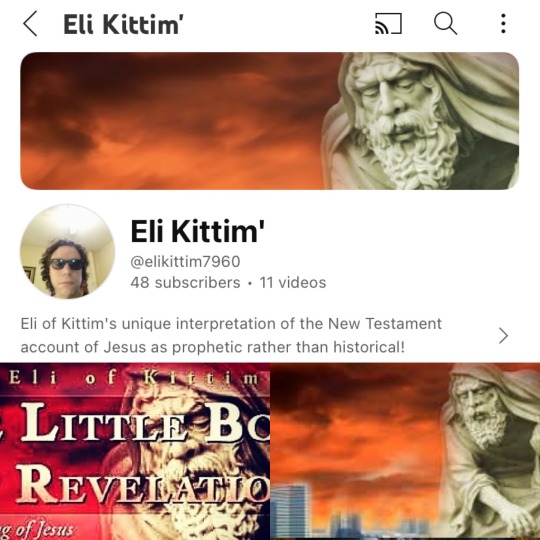#Eliofkittim
Text

Kittim’s Eschatology:
The Kittim Method
By Eli Kittim 🎓
Kittim’s eschatology is a view in biblical studies that interprets the story of Jesus in exclusively eschatological terms. This unique approach was developed by Eli of Kittim, especially in his 2013 work, “The Little Book of Revelation.” Kittim doesn’t consider Jesus' life as something that happened in history but rather as something that will occur in the last days as a fulfillment of bible prophecy. It involves a new paradigm shift! Kittim holds to an exclusive futuristic eschatology in which the story of Jesus (his birth, death, and resurrection) takes place once and for all (hapax) in the end-times. Kittim’s eschatology provides a solution to the historical problems associated with the historical Jesus.
Biographising the Eschaton: The Proleptic Eschatology of the Gospels
Kittim views God's inscripturated revelation of Jesus in the New Testament gospel literature as a proleptic account. That is to say, the New Testament gospels represent the future life of Jesus as if presently existing or accomplished. According to “The Free Dictionary,” the term “prolepsis” refers to “the anachronistic representation of something as existing before its proper or historical time.”
According to Eli Kittim, the gospels are therefore written before the fact. They are conveyed from a theological angle by way of a proleptic narrative, a means of biographising the eschaton as if presently accomplished. By contrast, Kittim’s work demonstrates that these events will occur at the end of the age. This argument is primarily founded on the authority of the Greek New Testament Epistles, which affirm the centrality of the future in Christ’s only visitation!
In the epistolary literature, the multiple time-references to Christ being “revealed at the end of the ages” (1 Pet. 1:20; cf. Heb. 9:26b) are clearly set in the future. It appears, then, that the theological purpose of the Gospels is to provide a fitting introduction to the messianic story beforehand so that it can be passed down from generation to generation until the time of its fulfillment. It is as though New Testament history is written in advance. It is therefore thought advisable, according to Kittim, to consider the collection of New Testament writings as strikingly futurist books.
The Epistolary View of Christ
The Epistles contradict the Gospels regarding the timeline of Christ’s birth, death, and resurrection by placing it in eschatological categories. The Epistolary authors deviate from the Gospel writers in their understanding of the overall importance of eschatology in the chronology of Jesus. For them, Scripture comprises revelations and “prophetic writings” (see Rom. 16:25-26; 2 Pet. 1:19-21; Rev. 22:18-19). Consequently, the Epistolary literature of the New Testament sets Christ’s birth, death, and resurrection in a different light, while apparently contradicting some of the Gospel material. Only the Epistles give us the real Jesus. Thus, in order to have a high view of scripture, one doesn’t have to accept the historicity of the Bible, or of Christianity for that matter!
Kittim’s Eschatology: The Kittim Method
Ephesians 2:4-7 alludes to a redemption established •in faith• prior to the coming of Jesus. This implies that believers in Christ can receive the Holy Spirit •retroactively• “through faith” (1 Pet. 1:3-5) based on the merits of the prophetic message revealed by God in the New Testament! Similarly, Titus 1:2-3 talks about a salvation which was promised a long time ago “but at the proper time revealed” (cf. Isa. 46:10). This is not unlike Hebrews 1:1-2 which states that Jesus speaks to humankind not in Antiquity but in the “last days” (ἐπ’ ἐσχάτου τῶν ἡμερῶν). First Peter 1:10-11 also suggests an eschatological soteriology, given that the holy spirit “predicted the sufferings of Christ.”
What is more, Second Peter 1:16-19 demonstrates that the so-called “eyewitness accounts” were actually based on visions (i.e. prophetic words) that were then written down as if they had already happened (proleptically). Similarly, Acts 3:19-21, in speaking about “the regeneration,” implies that the Messiah will not be sent to earth “until the time of universal restoration” (cf. Mt. 19:28). Put differently, the legend of Jesus precedes his arrival.
The same anachronistic (or proleptic) interpretation is brought to bear on the issue of the Messiah’s future incarnation in Revelation 12:5. Despite the fact that the reference to Christ’s birth in Revelation 12:5 is clearly future, Christian theology has, nevertheless, always maintained that it already happened. Thus, the notion of a historical Jesus does not square well with the context and content of these prophecies. In fact, according to Luke 17:30, the Son of Man has not yet been revealed (cf. 1 Cor. 1:7; Phil. 1:6; Col. 3:4; 2 Thess. 1:7; 1 Tim. 6:14; 2 Tim. 4:1; Titus 2:13; 1 Pet. 1:13; 1 Jn. 2:28). That’s precisely why the New Testament accounts of Jesus are essentially prophetic. For example, according to Revelation 19:10d, “the testimony [to] Jesus is the spirit of prophecy”!
Christ is born in the Fullness of Time
Interestingly enough, Ephesians 1:9-10 defines “the fullness of time” (τὸ πλήρωμα τοῦ χρόνου, which we also find in Galatians 4:4) as the consummation of the ages. Thus, according to Galatians 4:4, Christ will be born in the end-times! That’s why 1 Peter 1:20 (NJB) informs us that although Christ was foreknown through visions and revelations by the agency of the Holy Spirit, nevertheless he will make his one and only appearance “at the final point of time.” What is more, Hebrews 9:26b (KJV) states quite explicitly that Jesus will die for the sins of the world “in the end of the world (KJV), or “at the end of the age” (NRSV). A historical-grammatical study of the phrase ἐπὶ συντελείᾳ τῶν αἰώνων demonstrates that it refers to “the end of the world” (cf. Mt. 13:39-40, 49; 24:3; 28:20; Dan. 12:4 LXX; see also G.W.H. Lampe [ed.], “A Patristic Greek Lexicon” [Oxford: Oxford U, 1961], p. 1340)!
Christ’s Death and Resurrection at the End of the Age
In the Greek NT, Romans 5:6 intimates with hardly any ambiguity that Christ “died” (ἀπέθανεν) at some unspecified time of human history by using the phrase κατὰ καιρὸν, which means “at the right time” (cf. 1 Tim. 2:6), or at “the proper time,” and does not necessarily warrant a reference to history. Similarly, Isaiah 2:19 offers us a markedly different interpretation concerning the timing of the LORD’s resurrection, namely, as an event that takes place in the end time. Isaiah does not simply say that “the LORD” rises, only to quickly evanesce, but that he “rises to terrify the earth.” In other words, there’s no 2,000 year gap between the LORD’s resurrection and judgment day. What is often overlooked in Isaiah 2:19 when doing exegetical work is the significance of the Hebrew term קוּם (qum), which is rendered in English as “rises,” and is often used in the Bible to mean “resurrection” (see e.g. Job 14:12; Isa. 26:19; Mk 5:41). Astoundingly, the LXX translates it as ἀναστῇ (i.e. resurrection). The word ἀναστῇ (e.g. Mk 9:9; Lk. 16:31) is a derivative of ἀνίστημι, which is the root word of ἀνάστασις and means to “raise up” or to “raise from the dead.”
There is biblical support for this conclusion in Daniel 12:1-2. For instance, the end-time death and resurrection of “the great prince” in Daniel 12:1 (παρελεύσεται Dan OG 12:1 LXX; ἀναστήσεται Dan Th 12:1 LXX) occur just prior to the general resurrection of the dead (Dan. 12:2). Similarly, “Christ the first fruits” is said to be the first to rise from the dead during the future general resurrection of the dead in 1 Corinthians 15:23. This is confirmed in Zephaniah 1:7 in which the Lord’s sacrificial-death takes place during “the day of the Lord”!
Conclusion
Exegetes must interpret the implicit by the explicit and the narrative by the didactic. In practical terms, the NT Epistles and other more explicit and didactic portions of Scripture must clarify the implicit meaning and significance of the Gospel literature. Accordingly, this paper argues that the Epistles are the primary keys to unlocking the future timeline of Christ’s only visitation.
——-
#historical jesus#septuagint#ελικιτίμ#DidJesusExist#historicalJesusStudies#theJesusprophecy#Earlywritings#thelittlebookofrevelation#bible translations#EK#EliofKittim#bible_exegesis#biblical_criticism_and_history_forum#Christian_texts_and_history_forum#endoftheage#Kittimbiblicalsystem#What_if_the_crucifixion_of_Christ_is_a_future_event#early_christianity#bible prophecy#thefutureincarnationofChrist#end of days#Kittimeschatology#ΤοΜικροΒιβλιοτηςΑποκαλυψης#academic_bible#thefullnessoftime#bible interpretation#Kittimsystematictheology#Συντέλειατουκόσμου#Kittimtheology#biblicaleschatology
5 notes
·
View notes
Text

Author Eli Kittim- YouTube Channel
__________________________
Author Eli of Kittim's unique interpretation of the New Testament account of Jesus!
__________________________
YouTube: https://www.youtube.com/@elikittim7960/videos
#christian writer#christian blogger#eliofkittimyoutube#elikittim#elikittimtumblr#the jesus prophecy#thelittlebookofrevelation#Bible researcher#eliofkittim#EK#goodreadsauthor#biblestudybook#endtimesbook#christian author#ΕλιΚιττίμ#τομικρόβιβλίοτηςαποκάλυψης#εκ#biblicaleschatology#christianvlogger#bibleprophecyexpert#bibleteacher#youtuber#christian videos online#Biblevideos#BibleProphecyVideos#Βιβλικέςπροφητείες#ΒιβλικάΒίντεο#Βιβλικήερμηνεία#Biblicalinterpretation#TheFirstComingofJesusattheEndofDays
0 notes
Text

📖 Scripture Quotes by Bible Teacher Eli Kittim 📚
#tumblr quotes#faith quotes#literature quotes#famous quotes#goodreadsauthor#αποσπάσματα#Biblicalliterature#gospelquotes#scripturequotes#dailyquotes#theologyquotes#bible quotes#τομικρόβιβλίοτηςαποκάλυψης#religious quotes#spiritual quotes#eliofkittim#bibleprophecyquotes#jesus quotes#christian quotes#The_Little_Book_of_Revelation#author quotes#christian author#αποσπάσματα_του_Ελι_κιτίμ#συγγραφέας_έλι_κιτίμ#elikittim#eli kittim follow#book quotes#bibledaily#quotes on tumblr#elikittimquotes
3 notes
·
View notes
Text

Eli Kittim on Instagram
Eli Kittim’s Unique Interpretation of Jesus
Eli Kittim’s eschatology is a view in biblical studies that interprets the story of Jesus in exclusively eschatological terms. This unique approach was developed by Eli of Kittim, especially in his 2013 work, The Little Book of Revelation. Kittim doesn’t consider Jesus' life as something that happened in history but rather as something that will occur in the last days as a fulfillment of bible prophecy. It involves a new paradigm shift! Kittim holds to an exclusive futuristic eschatology in which the story of Jesus (his birth, death, and resurrection) takes place once and for all in the end-times (see Heb. 9:26b; 1 Pet. 1:20). Kittim’s eschatology provides a solution to the historical problems associated with the historical Jesus.
#Kittimeschatology#Kittimsystematictheology#futuristeschatology#Eliofkittim#Goodreadsauthor#publishedauthor#ek#Hebrews9v26#1Peter1v20#ΕλιΚιτίμ#koine greek#kittimtheology#τομικροβιβλιοτηςαποκαλυψης#the little book of revelation#eok#questforthehistoricalJesus#theGreekJesus#theJesusProphecy#HistoricalJesusStudies#biblicalresearcher#EliKittim#εκ#έλληναςΙησούς#θεολόγος#thefirstcomingofJesusattheendofdays#theGodofGreece#biblestudies#ΦουτουριστικήΕσχατολογία#bible translation#Έλληναςσυγγραφέας
0 notes
Text

Study the Bible with the “Eli of Kittim Bible Exegesis Group” (on Facebook)
If you're interested in Bible exegesis, Biblical languages and interpretation, then join the #Eli_of_Kittim_Bible_Exegesis_Group on Facebook.
#facebook group#biblestudygroup#theology group#bibleprophecygroup#biblicaleschatology#Jesusstudies#scholarlygroup#biblicalinterpretation#Biblecriticism#Christinprophecy#bibleexegesis#biblical hermeneutics#KoineGreek#facebook#eliofkittim#elikittimbiblestudy#biblical hebrew#academicgroup#joingroup#bible translation#ελικιτίμ#bible scholar#christianforum#Έλι Κιτίμ Ομάδα Ερμηνείας της Βίβλου στο Facebook#EK#ايلي#eli kittim follow#the little book of revelation#Eli kittim prophecy news#MeWe.com
0 notes
Text

The Little Book of Revelation (Xlibris):
By Eli Of Kittim 🎓📚
A Study of the Sequence of EndTime Events
Eli Kittim – Das kleine Buch der Offenbarung: Das erste Kommen Jesu in den letzten Tagen
엘리 킷팀(Eli Kittim) - 작은 요한계시록: 마지막 날에 예수님의 초림
Eli Kittim - Mica carte a Apocalipsei: Prima venire a lui Isus la sfârșitul zilelor
Eli Kittim - Ang Munting Aklat ng Pahayag: Ang Unang Pagdating ni Hesus sa Katapusan ng mga Araw
イーライ・キティム - 小さな黙示録: 終わりの日のイエスの初臨
ایلی کٹیم - مکاشفہ کی چھوٹی کتاب: آخری دنوں میں یسوع کی پہلی آمد
#ΕλιΚιτίμ#ΤοΜικροΒιβλιοΤηςΑποκαλυψης#Xlibris#bookstore#softcover#hardcover#ebook#award winning books#christian books#tradebook#Greekmessiah#biblestudybook#βιβλιο#thefutureincarnationofchrist#eschatologybook#bibleprophecybook#nonfiction books#EliofKittim#βραβευμένοβιβλίο#christian author#Έλληναςμεσσίας#εκδόσεις#βιβλίομημυθοπλασίας#χριστιανικόβιβλίο#theJesusprophecy#προφητείεςτηςΒίβλου#the little book of revelation#ημελλοντικήενσάρκωσητουΧριστού#the_birth_death_and_resurrection_of_Christ_according_to_the_greek_new_testament_epistles#Έλληναςσυγγραφέας
0 notes
Photo

#Interview_with_Eli_Kittim #Author_of_The_Little_Book_of_Revelation https://rhondapattonauthor.wordpress.com/2018/07/06/welcome-author-eli-of-kittim/
#wordpress#blog#elikittiminterview#author#thelittlebookofrevelation#interview#literature#writers#christianauthors#elikittimauthor#scripture#books#bookstagram#eliofkittim#awardwinningauthor#bible#nonfictionbooks#tumblrbooks
4 notes
·
View notes